Google Display Ad Sizes: Which Formats Work Best?
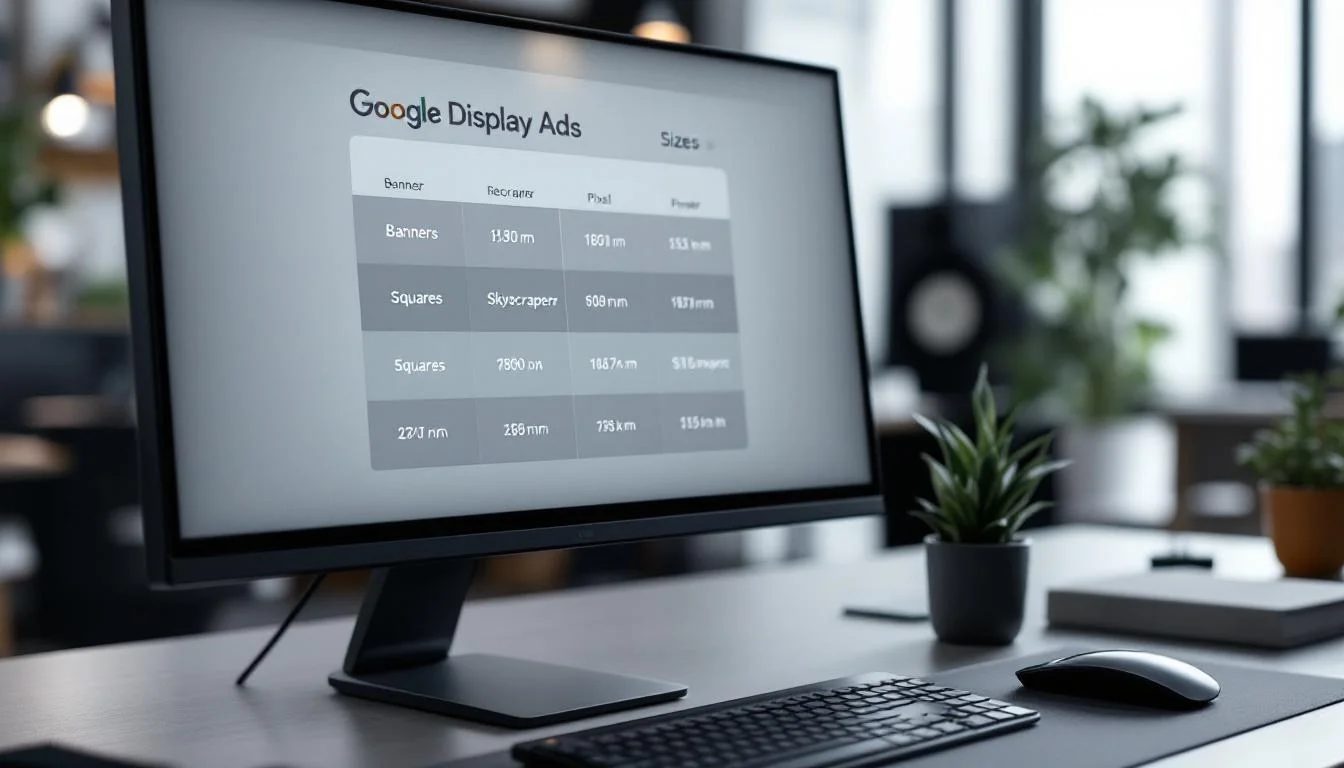
At Drop Cowboy, we know that choosing the right Google Ads display size can make or break your advertising campaign.
The Google Display Network offers a wide array of ad formats, each with its own strengths and ideal use cases.
In this post, we’ll explore the most effective Google display ad sizes and help you determine which ones will work best for your marketing goals.
What Are Google Display Ad Sizes?
The Power of the Google Display Network
The Google Display Network (GDN) stands as a titan in digital advertising, reaching over 90% of internet users worldwide. This vast network comprises millions of websites, apps, and videos where ads can appear. The GDN’s extensive reach allows advertisers to target specific audiences based on demographics, interests, and browsing behavior. Google reports that the GDN serves over a trillion impressions each month, offering unparalleled exposure for businesses of all sizes.
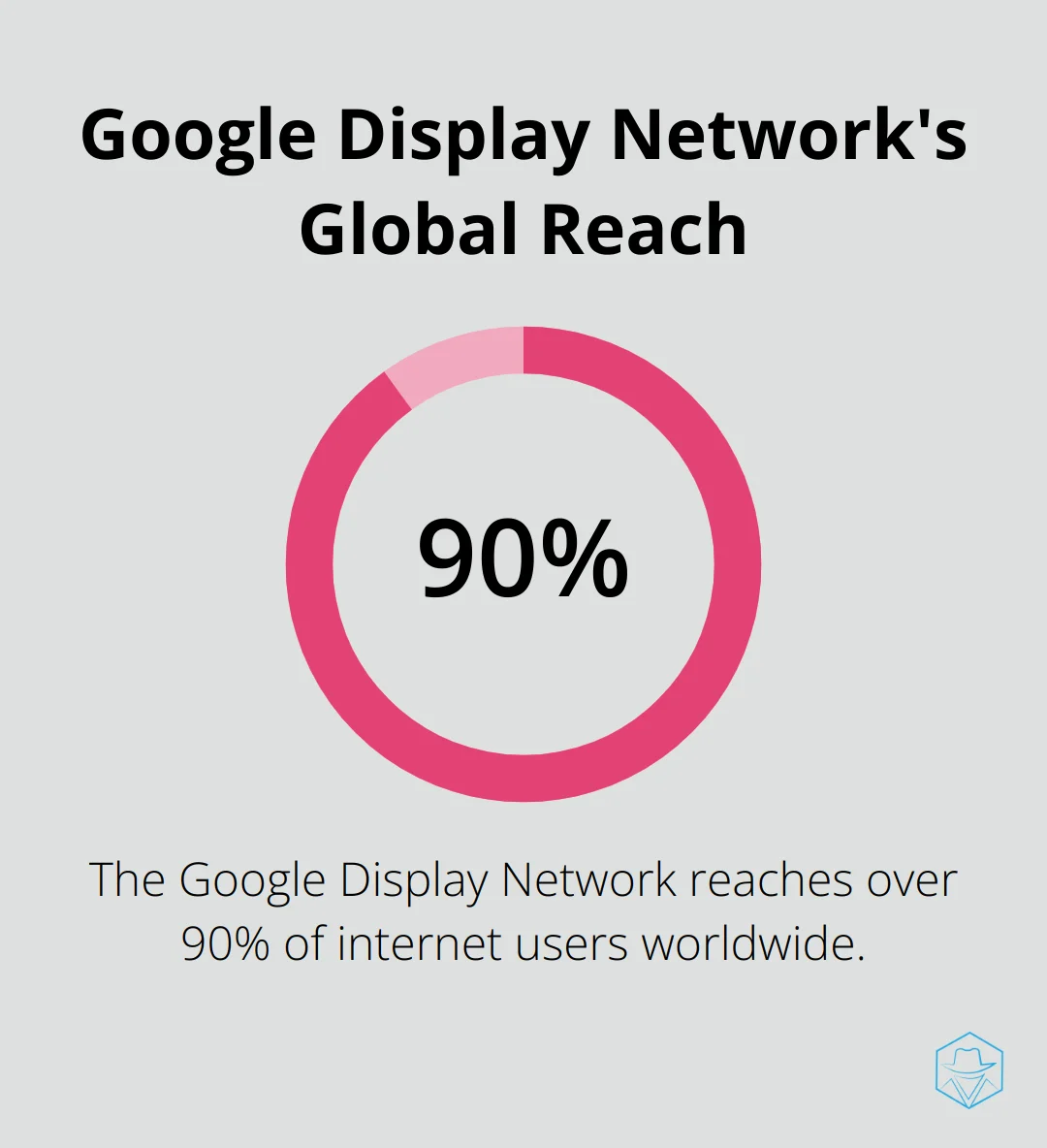
The Strategic Importance of Ad Size
Selecting the right ad size transcends mere technical requirements; it’s a strategic decision that can dramatically impact campaign success. Different ad sizes excel in various placements and on different devices. A WordStream study revealed that the 300×250 Medium Rectangle ad size consistently outperforms other formats in terms of click-through rates.
Popular Google Display Ad Formats
Google offers a variety of ad formats to accommodate different marketing needs and website layouts. Some of the most effective sizes include:
- Leaderboard (728×90): This format works best for desktop placements, typically at the top of web pages.
- Medium Rectangle (300×250): This versatile size proves effective across devices.
- Large Rectangle (336×280): It offers more space for content and performs well on desktops.
- Mobile Leaderboard (320×50): This size optimizes for mobile devices, often placed at the top or bottom of mobile screens.
Each of these formats boasts unique strengths. For instance, the Half Page (300×600) ad size has gained popularity due to its effectiveness on mobile devices and ample space for content. A Bannerflow report indicates this format has seen a 30% increase in usage over the past year.
Emerging Trends in Display Advertising
Video banners continue to rise in popularity, with Google reporting a 100% year-over-year increase in video ad impressions. These dynamic ads significantly boost engagement, especially on mobile platforms where users tend to interact more with video content.
Interactive elements in display ads (such as mini-games or animations) also show promising results. A Celtra study found that interactive ads can increase engagement rates by up to 400% compared to static ads.
As we move forward, it’s essential to understand how these various ad sizes and formats perform in real-world scenarios. Let’s explore the most effective Google display ad sizes and their performance statistics in the next section.
Which Ad Sizes Dominate Google Display?
Leaderboard (728×90): The Desktop Champion
The Leaderboard format continues to excel in desktop advertising. A recent Google Ads benchmark report reveals this size achieves an average click-through rate (CTR) of 0.47%. Its horizontal layout proves ideal for above-the-fold content, instantly capturing user attention when a page loads.
Pro tip: Leaderboards work wonders for brand awareness campaigns. Their wide format accommodates eye-catching visuals and clear messaging, perfect for creating lasting impressions.
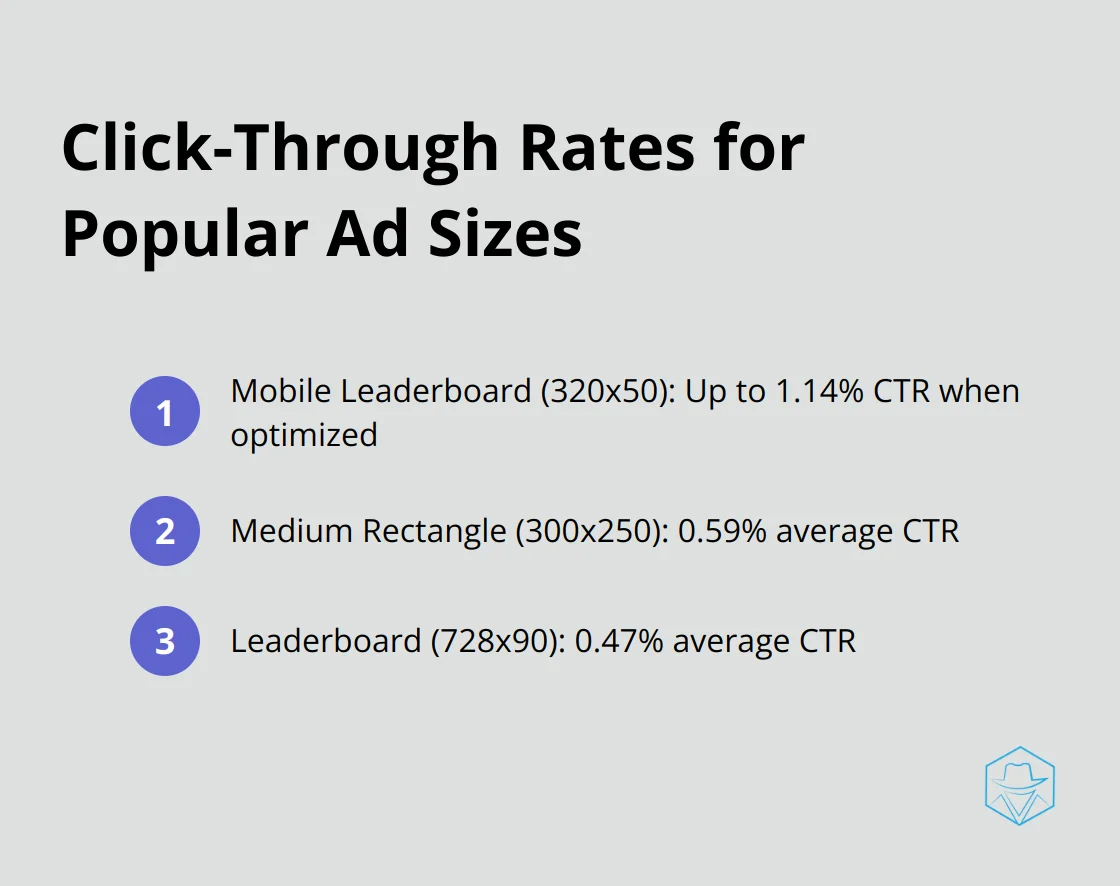
Medium Rectangle (300×250): The Versatile Performer
The Medium Rectangle stands out as the Swiss Army knife of display ads. It performs admirably across devices and placements, making it a flexible choice for any campaign. WordStream data shows this format reaching an impressive average CTR of 0.59%.
This format works exceptionally well when embedded within content. Such placement feels less intrusive to users, often resulting in higher engagement rates.
Large Rectangle (336×280): The Content Powerhouse
Advertisers with more to convey will appreciate the Large Rectangle’s additional real estate. This format shines on desktop placements, particularly when positioned alongside editorial content.
A Bannersnack study uncovered that Large Rectangles boast a 25% higher engagement rate compared to their medium counterparts. This extra space allows for more detailed messaging or compelling visuals (perfect for product showcases or service explanations).
Mobile Leaderboard (320×50): The Smartphone Specialist
As mobile traffic dominates internet usage, the Mobile Leaderboard has become indispensable. This compact format captures attention without overwhelming small screens.
Google’s data indicates that Mobile Leaderboards can achieve CTRs as high as 1.14% when properly optimized. To maximize performance, use clear, concise messaging and high-contrast designs that stand out even on the smallest screens.
Optimizing Your Ad Size Strategy
While these sizes have proven their effectiveness, success in display advertising requires continuous testing and optimization. Experiment with different sizes and placements to find the perfect fit for your unique audience and goals.
The next chapter will explore the critical factors to consider when selecting the right ad sizes for your campaigns. Understanding these elements will help you make informed decisions and maximize your advertising ROI.
How to Choose the Right Ad Size
Understand Your Audience’s Device Preferences
The devices your audience uses should guide your ad size selection. Statista reports that mobile devices account for 54.8% of global web traffic. This percentage likely increases for younger demographics.
For mobile-heavy audiences, formats like the 320×50 Mobile Leaderboard or 300×250 Medium Rectangle work well. These sizes display effectively on smaller screens without disrupting user experience.
If you target professionals during work hours, desktop-friendly sizes such as the 728×90 Leaderboard or 336×280 Large Rectangle might produce better results.
Match Website Layouts
Available ad space on publisher websites impacts your size choices significantly. A Google AdSense study showed that ads placed above the fold (visible without scrolling) perform up to 5x better than those below.
For remarketing campaigns on specific sites, research their layouts. Many news sites have dedicated spaces for 300×600 Half Page ads in their sidebars. Matching your ad size to these premium spots can boost visibility dramatically.
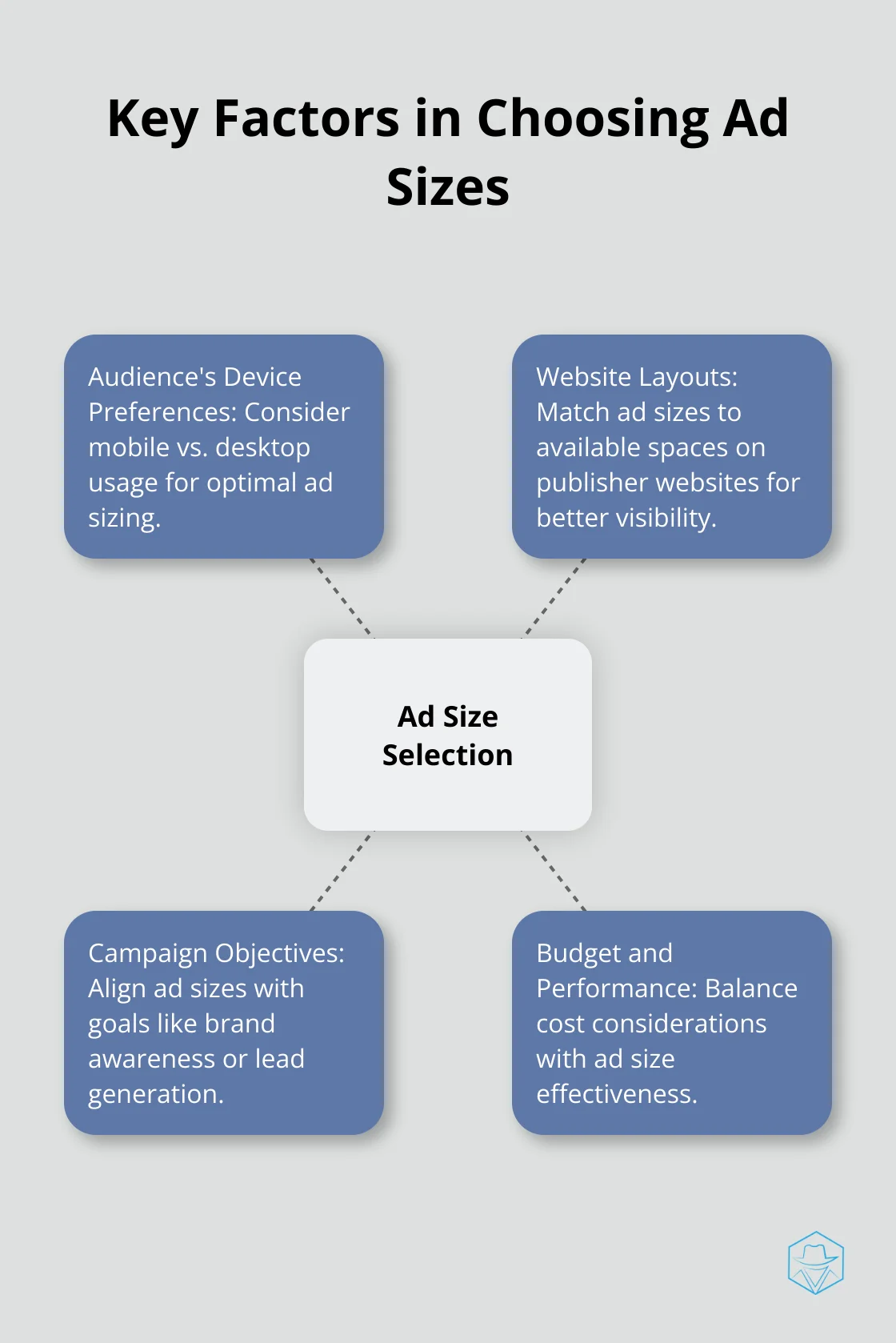
Align with Campaign Objectives
Your campaign goals should heavily influence your ad size strategy. For brand awareness, larger formats like the 970×250 Billboard can create a lasting impression. A Nielsen study found that larger ad units increased brand recall by up to 38%.
For direct response or lead generation, more compact sizes often perform better. The 300×250 Medium Rectangle, for instance, has consistently high click-through rates across industries.
Consider Budget and Performance
Larger ad sizes can catch the eye, but they often come with a higher price tag. A WordStream analysis revealed that the average cost-per-click (CPC) for a 300×250 Medium Rectangle was $0.63, compared to $1.12 for a 336×280 Large Rectangle.
With a limited budget, start with more affordable sizes and gradually test larger formats. This approach can help you find the optimal balance between cost and performance.
The most expensive option doesn’t always yield the most effective results. Well-designed, strategically placed smaller ads can achieve remarkable outcomes (often at a fraction of the cost).
Final Thoughts
Google display ad sizes significantly impact digital marketing success. The top-performing formats – Leaderboard (728×90), Medium Rectangle (300×250), Large Rectangle (336×280), and Mobile Leaderboard (320×50) – offer unique advantages for various scenarios. Continuous testing and optimization of these formats will reveal insights about your audience’s preferences and behavior.
Start with versatile formats like the 300×250 Medium Rectangle, which performs well across devices. As you collect data, experiment with other sizes to find the perfect fit for your specific audience and goals. Compelling visuals, clear messaging, and strategic placement are equally important for driving engagement and conversions.
At Drop Cowboy, we understand the importance of a holistic approach to digital marketing. Our platform offers tools to enhance your campaigns beyond display ads, including ringless voicemail and SMS marketing. The digital advertising landscape evolves constantly, so stay curious, keep testing, and try new strategies to create powerful campaigns that resonate with your audience and drive real results.
blog-dropcowboy-com
Related posts

May 9, 2025
Lead Generation with Marketing Automation
Boost sales and save time with marketing automation for Shopify. Learn proven strategies to enhance lead generation and streamline your processes.

August 11, 2025
Slybroadcast api
Explore Slybroadcast API capabilities for seamless business communication. Learn how it enhances efficiency and connects effortlessly with audiences.

August 13, 2025
What does it mean when u call someone and it goes straight to voicemail
Explore what it means when you call someone and it goes straight to voicemail. Understand why it happens and learn effective communication tips.
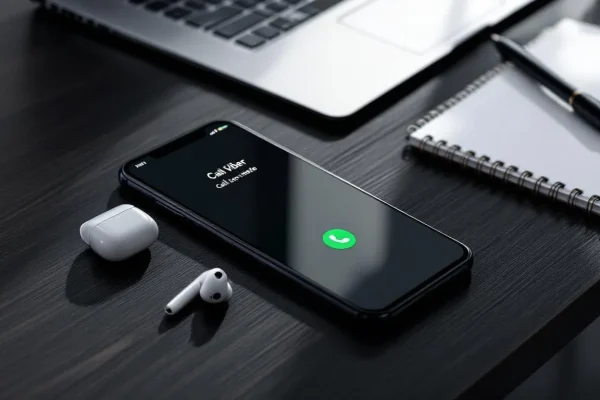
August 4, 2025
How to call someone and go straight to voicemail
Learn how to call someone and go straight to voicemail seamlessly with our tips. Optimize your communication without ringing interruptions.

August 4, 2025
What does it mean when it goes straight to voicemail
Uncover what it means when it goes straight to voicemail, explore causes, and gain insights into resolving missed connection issues effectively.
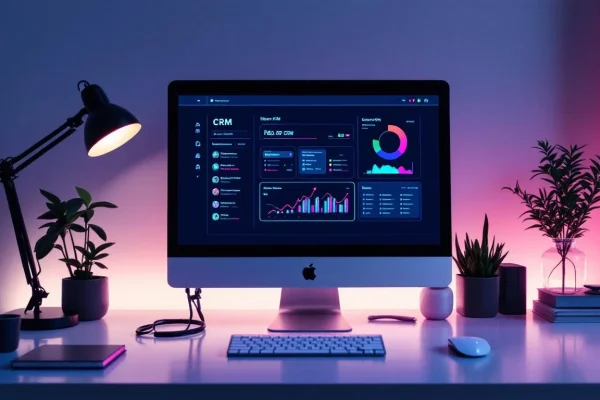
June 4, 2025
Neon CRM Pricing: Is It Worth the Investment?
Explore Neon CRM pricing and find out if it’s worth the investment for your organization with an in-depth analysis of costs and benefits.